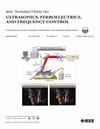Study on Loss Mechanisms in SAW Resonators Using 42-LT Thin Plate by Full-3-D FEM With Hierarchical Cascading Technique
IF 3.7
2区 工程技术
Q1 ACOUSTICS
IEEE transactions on ultrasonics, ferroelectrics, and frequency control
Pub Date : 2025-02-19
DOI:10.1109/TUFFC.2025.3543541
引用次数: 0
Abstract
This article describes the study of loss mechanisms in an incredible high-performance surface acoustic wave (IHP SAW) resonator on the 42°YX-LiTaO3/SiO2/Si structure. The full 3-D finite element method (FEM) is applied with the assistance of the hierarchical cascading technique (HCT). Excellent agreement is obtained between calculation and measurement not only for the effective electromechanical coupling factor基于层次级联技术的42-LT薄板SAW谐振器损耗机理的全三维有限元研究。
本文描述了在42°YX-LiTaO3/SiO2/Si结构上的超高性能表面声波(I.H.P. SAW)谐振器的损耗机制研究。在层次级联技术的辅助下,采用了全三维有限元法。在不考虑经验损耗机制的情况下,有效机电耦合系数keff2和波德Q的计算结果与实测结果非常吻合。计算得到的波德Q的行为主要受IDT指对数NI和孔径长度w的影响。在反射器母线区域观察到斜向声表面波泄漏,当NI较大时可以忽略不计。由此得出结论,本文讨论的波德Q降低主要是由面内衍射引起的斜SAW泄漏引起的。最后,应用mBVD模型进行了定量表征。结果表明,mBVD模型可以很好地模拟面内SAW衍射,并且只对反共振q有显著影响。令人惊讶的是,即使NI=100,反共振q的损耗也占主导地位。
本文章由计算机程序翻译,如有差异,请以英文原文为准。
求助全文
约1分钟内获得全文
求助全文
来源期刊
CiteScore
7.70
自引率
16.70%
发文量
583
审稿时长
4.5 months
期刊介绍:
IEEE Transactions on Ultrasonics, Ferroelectrics and Frequency Control includes the theory, technology, materials, and applications relating to: (1) the generation, transmission, and detection of ultrasonic waves and related phenomena; (2) medical ultrasound, including hyperthermia, bioeffects, tissue characterization and imaging; (3) ferroelectric, piezoelectric, and piezomagnetic materials, including crystals, polycrystalline solids, films, polymers, and composites; (4) frequency control, timing and time distribution, including crystal oscillators and other means of classical frequency control, and atomic, molecular and laser frequency control standards. Areas of interest range from fundamental studies to the design and/or applications of devices and systems.

 求助内容:
求助内容: 应助结果提醒方式:
应助结果提醒方式:


